|
|
|
ADVERTISEMENTS
|
|
PREMIUM
- HAPPY HOLIDAYS!
- Siliconeer Mobile App - Download Now
- Siliconeer - Multimedia Magazine - email-Subscription
- Avex Funding: Home Loans
- Comcast Xfinity Triple Play Voice - Internet - TV
- AKSHAY PATRA - Bay Area Event - Sat. Dec 6
- Calcoast Mortgage - Home Loans
- New Homes in Silicon Valley: City Ventures - Loden Place - Morgan Hill
- Bombay to Goa Restaurant, Sunnyvale
- Buying, Sellling Real Estate in Fremont, SF Bay Area, CA - Happy Living 4U - Realtor Ashok K. Gupta & Vijay Shah
- Sunnyvale Hindu Temple: December Events
- ARYA Global Cuisine, Cupertino - New Year's Eve Party - Belly Dancing and more
- Bhindi Jewellers - ROLEX
- Dadi Pariwar USA Foundation - Chappan Bhog - Sunnyvale Temple - Nov 16, 2014 - 1 PM
- India Chaat Cuisine, Sunnyvale
- Matrix Insurance Agency: Obamacare - New Healthcare Insurance Policies, Visitors Insurance and more
- New India Bazar: Groceries: Special Sale
- The Chugh Firm - Attorneys and CPAs
- California Temple Schedules
- Christ Church of India - Mela - Bharath to the Bay
- Taste of India - Fremont
- MILAN Indian Cuisine & Milan Sweet Center, Milpitas
- Shiva's Restaurant, Mountain View
- Indian Holiday Options: Vacation in India
- Sakoon Restaurant, Mountain View
- Bombay Garden Restaurants, SF Bay Area
- Law Offices of Mahesh Bajoria - Labor Law
- Sri Venkatesh Bhavan - Pleasanton - South Indian Food
- Alam Accountancy Corporation - Business & Tax Services
- Chaat Paradise, Mountain View & Fremont
- Chaat House, Fremont & Sunnyvale
- Balaji Temple - December Events
- God's Love
- Kids Castle, Newark Fremont: NEW COUPONS
- Pani Puri Company, Santa Clara
- Pandit Parashar (Astrologer)
- Acharya Krishna Kumar Pandey
- Astrologer Mahendra Swamy
- Raj Palace, San Jose: Six Dollars - 10 Samosas
CLASSIFIEDS
MULTIMEDIA VIDEO
|
|
|
|
|
COVER STORY
Be Counted!
2010 U.S. Census
It is vital that community activists and leaders ensure that all Indian Americans are counted in the forthcoming U.S. Census, because in a democracy there is strength in numbers, writes Inder Singh.
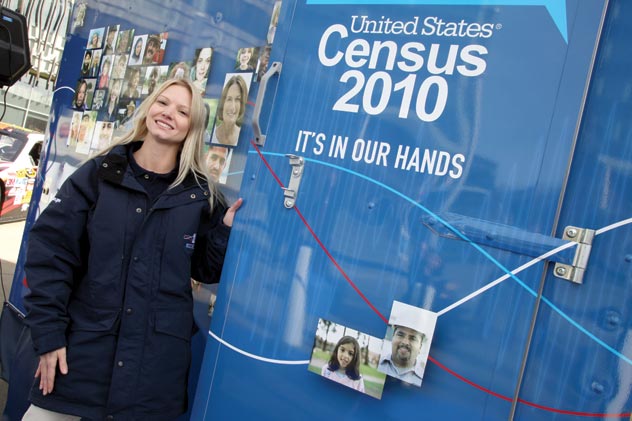
(Above): One of the regional road tour staff members helps to set up the road tour experience at a preview event at Census Bureau headquarters in Suitland, Md. (U.S. Census Bureau photo)
(Cover photo): A 2010 Census Road Tour Sprinter cargo van. The 2010 Census Road Tour regional vehicles are Sprinter cargo vans towing a 14-foot bumper pull trailer. The 12 vehicles will tour the country from January to April, promoting participation in the 2010 Census. (U.S. Census Bureau photo)
Quick question: If you are not a U.S. citizen, do you need to participate in the upcoming census? If your answer is a confident no, let me assure you that you are wrong.
The decennial census counts everybody who currently resides in the United States. What if you have immigration issues? Not a problem. The U.S. Census Bureau, which is under the U.S. Department of Commerce, does not deal with immigration, nor does it share any information with the immigration authorities, who fall under the purview of the U.S. Department of Justice.
The upshot of all this is that everyone can participate in the forthcoming U.S. census, and what’s more important there is no excuse not to participate.
I know all of us are tired of filling up complicated forms, particularly those of the government variety which seem have a perverse talent for abstruse language.
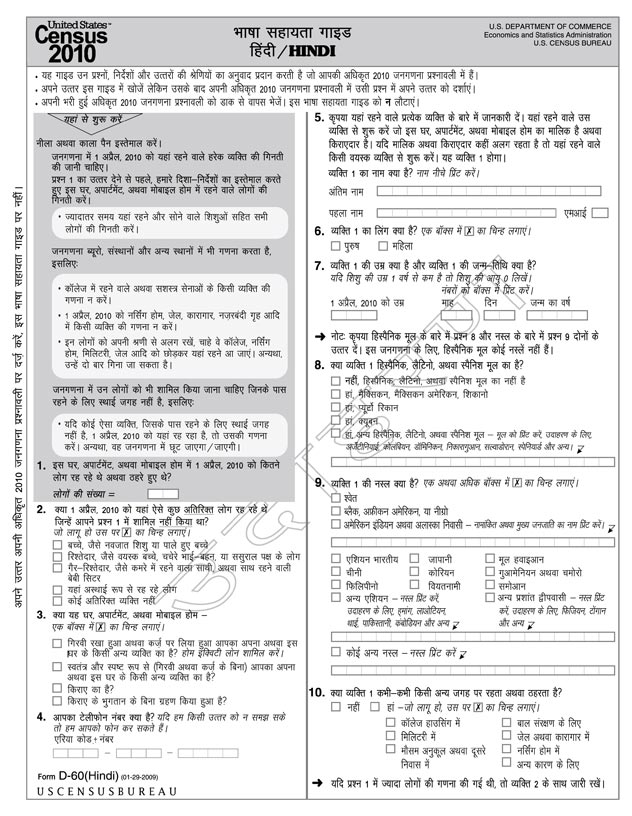
(Above): A Hindi version of the census form to facilitate comprehension for Hindi speakers with limited English language skills. (U.S. Census Bureau photo)
But trust me, this is one form that it is vitally important to fill and submit. If you don’t participate in the census, you don’t get counted. If there are a whole lot of South Asians who don’t do it, that means the U.S census will not reflect the true numerical strength of the South Asian community here.
In a democracy like the U.S., that has enormous consequences.
The U.S. government is doing its bit to reach out to all ethnic minorities.
Full page advertisements for United States Census 2010 are currently appearing in many Indian newspapers in the U.S. It mentions the importance of being counted and assures that the U.S. law “protects confidentiality” of the respondents. It also assures that the Immigration Department, IRS, FBI, CIA or the local police will not have access to any of the information in the Census document.
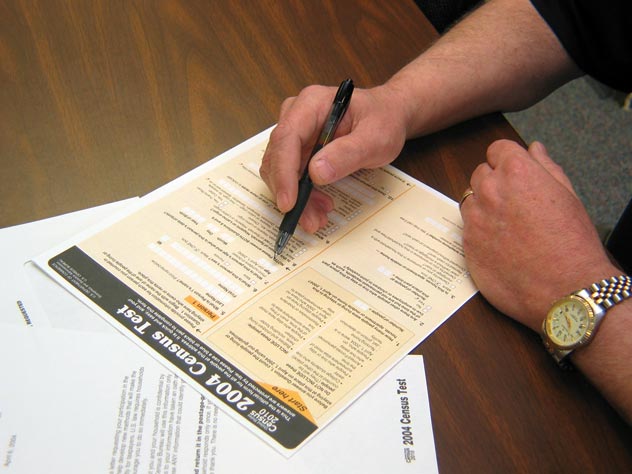
(Above): A U.S. Census 2010 form. Most respondents will get a short version, but a few people will get a longer version that goes into more detail. (U.S. Census Bureau photo)
The 2010 Census is a count of everyone living in the United States and is mandated by the U.S. Constitution. Whether you are a citizen, legal or illegal immigrant, on tourist visa or H1-B visa, or even have no visa, the law encourages everyone on U.S. soil to respond to the Census 2010 questionnaire. The Indian community in the U.S. can “help improve schools, increase job training and get its share of over $400 billion per year in federal funds” provided every Indian household “answers 10 simple questions and mails the census questionnaire back to the Census Bureau.” A large majority of people will get the short form with ten questions while some, randomly selected, will be surveyed in depth. However, the usefulness of the information will directly relate to the accuracy with which you respond to each of the questions.
Thirty years ago, the U.S. Census Bureau counted 361,544 Indian Americans living in the United States. This number was one-sixth of one percent of 226.5 million U.S. population in 1980. The Indian community predominantly comprised of those who migrated from India and adopted the U.S. as their new homeland. Ten years later, according to the 1990 census, the number of Indian Americans rose to 815,447, more than double the previous count. By then the community also included a large number of those who were born and raised in the United States. In 2000, the census count of Indian Americans – immigrants, citizens, visitors from India, H-1B visa holders, officials of Indian Embassy and Consulates, Indian employees of other non-governmental Indian agencies, such as banks, etc. – was 1.67 million, slightly more than double the 1990 census count.
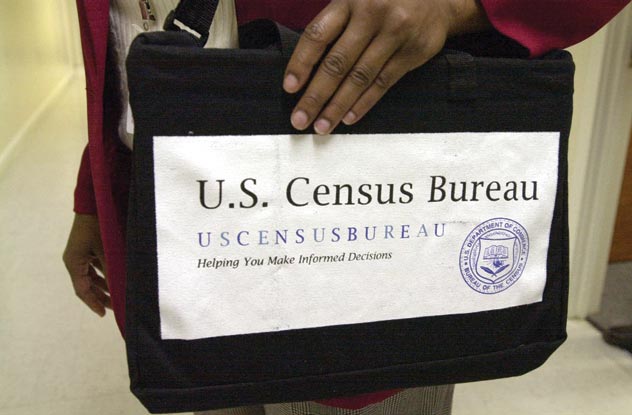
(Above): Every Census Bureau worker will carry an official bag like this.
(Below, right): Census Bureau representatives will go door-to-door, especially to people who have not responded. (U.S. Census Bureau photos)
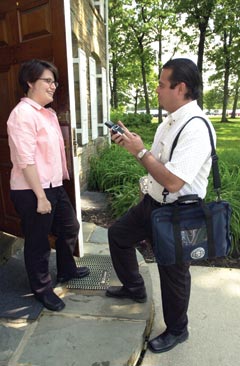 The 2010 Census is again a number-dependent game. We can participate in it to our advantage by having a complete and accurate count of our community. In March 2010, the Census Bureau will mail a census questionnaire to all households in the U.S. The Indian American community has an edge over the general U.S. population as it is highly educated and will need little outside help to fill the census form. All Indian Americans should make a sincere effort to complete the census questionnaire and return before the April 1 deadline. The Indian American community can use its numerical strength to demand its fair share of the funds and services allocation pie. The increased number can be effectively considered as our community’s strength and clout. We can become a force to reckon with against misrepresentation of our culture or negative presentation of our professionals in the movies and other media, as well as in academia, politics and the professions. An accurate count of Indian Americans in the United States could translate into dollars flowing for services to our community during the next 10 years. It could also mean increased number of political appointments at federal, state and city level for Indian Americans. This is truly our chance to be properly and accurately counted as part of the fabric of American life. The 2010 Census is again a number-dependent game. We can participate in it to our advantage by having a complete and accurate count of our community. In March 2010, the Census Bureau will mail a census questionnaire to all households in the U.S. The Indian American community has an edge over the general U.S. population as it is highly educated and will need little outside help to fill the census form. All Indian Americans should make a sincere effort to complete the census questionnaire and return before the April 1 deadline. The Indian American community can use its numerical strength to demand its fair share of the funds and services allocation pie. The increased number can be effectively considered as our community’s strength and clout. We can become a force to reckon with against misrepresentation of our culture or negative presentation of our professionals in the movies and other media, as well as in academia, politics and the professions. An accurate count of Indian Americans in the United States could translate into dollars flowing for services to our community during the next 10 years. It could also mean increased number of political appointments at federal, state and city level for Indian Americans. This is truly our chance to be properly and accurately counted as part of the fabric of American life.
Since 1790, the census in the United States is taken every 10 years. The earliest censuses were simple tallies of individuals in each household for the sole purpose of equal apportionment of federal House (of Representatives) seats among the states. But policymakers in the U.S. Congress and elsewhere started adding questions on the census form to gather meaningful data about the U.S. population. The Census Bureau has constantly monitored and evaluated the changing societal needs and added new questions or dropped unnecessary ones from the survey form.
In 1988, the Census Bureau wanted to eliminate various sub-groups under the group titled “Asian” on the 1990 census form. A bill was introduced in the U.S. Congress, proposing elimination of the nine check-off boxes including Asian Indian, Chinese, Korean, Japanese, etc. The Asian leaders opposed the bill and eventually succeeded in that effort. Thus, the Asian people continue to be the only major group of U.S. population for which statistics by their country of origin are collected and are maintained by the U.S. Census Bureau. The recognition of Asian Indians as a separate sub group on the census form gives us a sense of pride. The Census Bureau collects, maintains and provides data with respect to the number of Indian Americans in the U.S, their household income, education level, etc. It is imperative that Indian Americans check the box titled “Asian Indian” in response to question 9 on the Census form for an accurate count of the Indian American population in the U.S.
 (Right): Families like this all over the United States will be completing U.S Census forms. The resulting information will give us a better idea about the diverse population of this nation. (U.S. Census Bureau photo) (Right): Families like this all over the United States will be completing U.S Census forms. The resulting information will give us a better idea about the diverse population of this nation. (U.S. Census Bureau photo)
The Indian American activists in 1980 voiced their concerns that our community count was not correctly reported. In the 1990 census, we tried to ensure that everybody from the community was included and no one knowingly was left out; not even the employees of public agencies, such as the Embassy of India, consular offices, State Bank of India, etc. The Census Bureau would like to avoid the pitfalls of the previous census. Millions of dollars are being poured into advertisements and billions more in hiring temporary staff for census related work. A multicultural and multilingual outreach campaign has already been launched. Publicity in the ethnic media, including Indian American media, has already started and that factor can help in convincing foreign-born residents to respond to the census questionnaire promptly – and without reservation or fear. Since the Census Bureau is determined to have complete and accurate count of all U.S. households, the census takers will go door-to-door to count residents who fail to return their form by April 1.
If a census worker knocks on your door, make sure that he/she has a badge, a handheld device, a Census Bureau canvas bag and a confidentiality notice. Do not hesitate to see his/her identification and badge before answering any questions. Also, A census worker will not contact you by e-mail. So, do not click on a link or open any attachments in an e-mail which are supposedly from the U.S. Census Bureau. A word of caution from Better Business Bureau and law agencies. Be cooperative with the U.S. census workers but do not give sensitive financial information. It is the scammers who could be impersonating census workers to gain access to your social security number, bank account or credit card numbers.
The U.S. Census Bureau also depends on voluntary help to spread the message to the masses. They have formed the Complete Count Committees of volunteers to increase awareness of the 2010 census and motivate residents in various communities to respond. These CCCs plan and implement census awareness campaigns that cater to the special characteristics of their communities. A number of CCCs are already functional and more are forming. If interested in organizing a committee, you can call the regional census center or visit www.2020.census.gov.
In the past, Indian organizations played a significant role in spreading the census message. They created grassroots outreach efforts geared toward reaching every segment of the Indian population. However, the community activists and cultural, social and religious organization heads cannot and should not take past achievements for granted. During the last few years, many Indian American regional, ethnic and professional organizations have gained more visibility, recognition and respectability and can play a major role in Census 2010. The leaders of all Indian American organizations, national or local, religious or social, political or professional, should band together to increase awareness about the census and work towards full participation of Indian Americans. They need to create awareness and highlight the benefits about the upcoming census count and provide leadership in addressing the census issue on a timely basis.
The community activists will be failing in their responsibility if they do not educate and encourage members of the Indian American community for one hundred percent response to the census questionnaire. They should identify and convince those who are hesitant or holdouts, and ensure that they stand up to be counted. They must understand that their objective is clearly defined, a full enumeration of people of Indian origin. Any inaction and timidity in pursuing that objective boldly and vigorously can result in less than deserved local community financing, representation and services for next 10 years.
|
Inder Singh is chairman of Global Organization of People of Indian Origin, past president of NFIA and founder/president of FIA, Southern California.
|
|
|
|
|
|